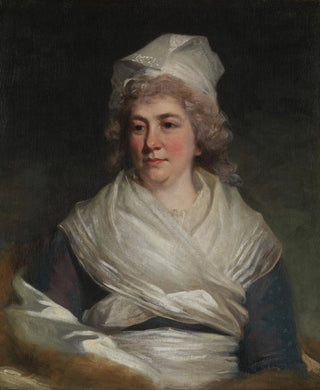Art print | Mme Richard Bache Sarah Franklin 1743-1808 - John Hoppner


View from behind

Frame (optional)
In the world of art, some works transcend the mere frame to become witnesses of an era, reflections of the human soul. "Mme Richard Bache Sarah Franklin 1743-1808 - John Hoppner" stands out as a masterpiece of this phenomenon. This portrait, created by the talented John Hoppner, immerses us in 18th-century America, a period marked by social and political upheavals. Sarah Franklin, an iconic figure of her time, embodies not only feminine grace but also the crucial role of women in the emerging American society. Through this painting, Hoppner captures a vibrant essence, an intimacy that invites the viewer to explore the complexities of this remarkable woman's life.
Style and uniqueness of the work
John Hoppner's style in this piece is a subtle blend of realism and romanticism, characteristic of his artistic approach. The delicacy of Sarah Franklin's features, the fluidity of her dress's drapery, and the sparkle in her eyes testify to undeniable technical mastery. Hoppner manages to infuse a psychological depth into his subject, making the art print not only visually captivating but also emotionally engaging. The harmony of colors, with warm hues and delicate shadows, creates an almost palpable atmosphere, where one can feel the presence of the protagonist. This art print does not merely depict a woman; it tells a story, that of a life rich in experiences, challenges, and contributions to society.
The artist and his influence
John Hoppner, born in 1758, was a British painter whose work marked his era. Trained in the portrait school, he made a name for himself by capturing the nobility and influential figures of his time. His style, influenced by masters such as Gainsborough and Reynolds, evolved to incorporate elements of romantic sensitivity, allowing him to stand out in the London art scene. Hoppner not only contributed to the evolution of portraiture but also paved the way for a new perception of women in art, highlighting their strength and individuality.

Matte finish

View from behind

Frame (optional)
In the world of art, some works transcend the mere frame to become witnesses of an era, reflections of the human soul. "Mme Richard Bache Sarah Franklin 1743-1808 - John Hoppner" stands out as a masterpiece of this phenomenon. This portrait, created by the talented John Hoppner, immerses us in 18th-century America, a period marked by social and political upheavals. Sarah Franklin, an iconic figure of her time, embodies not only feminine grace but also the crucial role of women in the emerging American society. Through this painting, Hoppner captures a vibrant essence, an intimacy that invites the viewer to explore the complexities of this remarkable woman's life.
Style and uniqueness of the work
John Hoppner's style in this piece is a subtle blend of realism and romanticism, characteristic of his artistic approach. The delicacy of Sarah Franklin's features, the fluidity of her dress's drapery, and the sparkle in her eyes testify to undeniable technical mastery. Hoppner manages to infuse a psychological depth into his subject, making the art print not only visually captivating but also emotionally engaging. The harmony of colors, with warm hues and delicate shadows, creates an almost palpable atmosphere, where one can feel the presence of the protagonist. This art print does not merely depict a woman; it tells a story, that of a life rich in experiences, challenges, and contributions to society.
The artist and his influence
John Hoppner, born in 1758, was a British painter whose work marked his era. Trained in the portrait school, he made a name for himself by capturing the nobility and influential figures of his time. His style, influenced by masters such as Gainsborough and Reynolds, evolved to incorporate elements of romantic sensitivity, allowing him to stand out in the London art scene. Hoppner not only contributed to the evolution of portraiture but also paved the way for a new perception of women in art, highlighting their strength and individuality.






